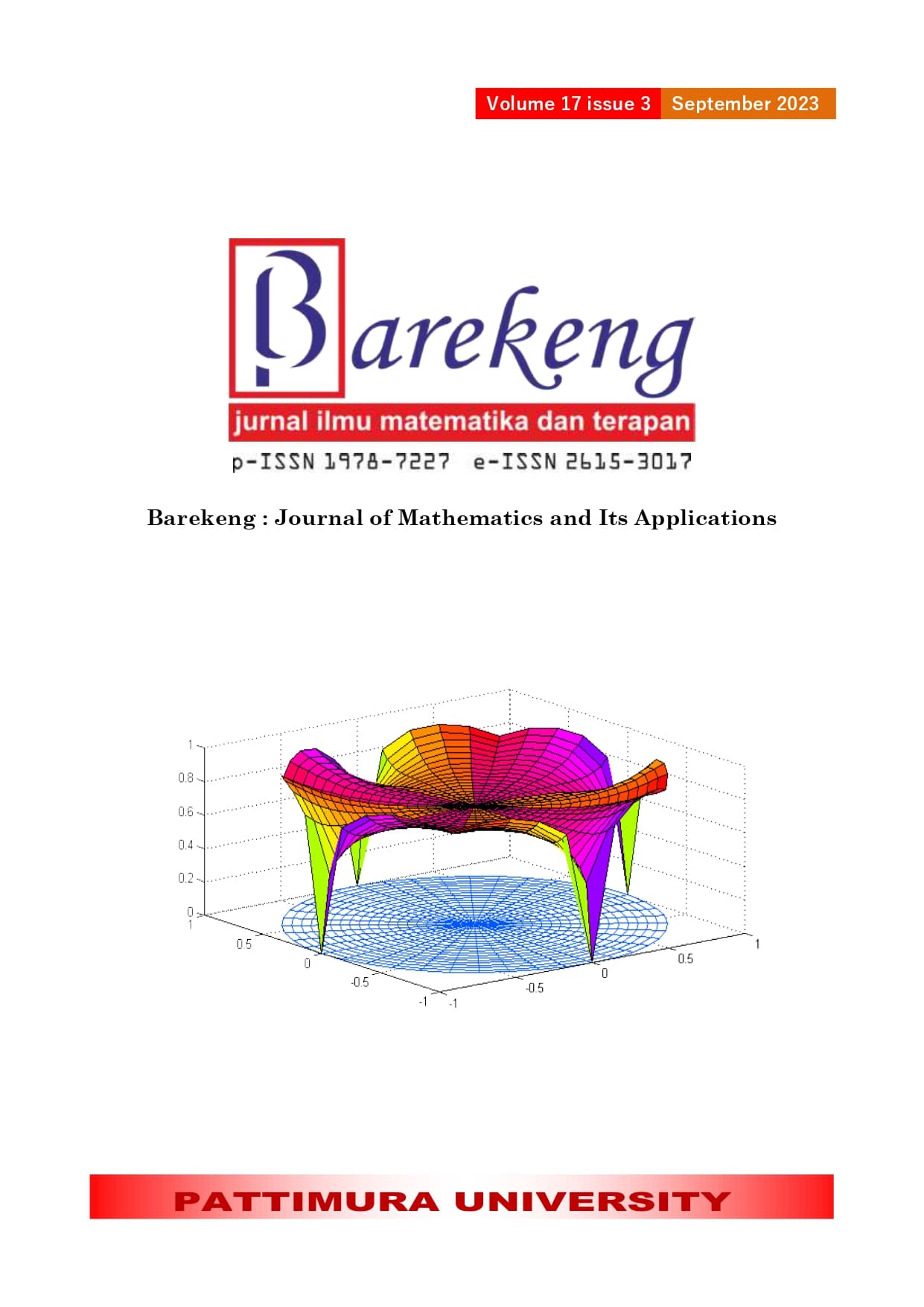CLUSTERIZATION OF REGION IN SOUTH SUMATERA BASED ON COVID-19 CASE DATA
Abstract
Based on Covid-19 case data as of July 2022, South Sumatra Province has the 15th highest rank out of 34 provinces in Indonesia, with confirmed cases totalling 82,407. This showed that the spread of Covid-19 in South Sumatra was still high. This study aimed to determine the cluster of regions in South Sumatra based on Covid-19 case data. Clustering regions used agglomerative hierarchical method. The process began with standardizing the data, calculating the similarity distance between objects, determining the optimal number of clusters using the Silhouette method, and the last was clustering analysis. This study found that the optimal number of clusters consisted of two clusters. The clustering process starts with objects 2 and objects 4 because these two objects have the closest similarity distance. In conclusion, objects with the closest similarity distance (in one cluster) have the same data movement (fluctuation).
Downloads
References
J. B. Soriano, S. Murthy, J. C. Marshall, P. Relan, and J. V. Diaz, “A clinical case definition of post-COVID-19 condition by a Delphi consensus,” Lancet Infect. Dis., vol. 22, no. 4, pp. e102–e107, 2022, doi: 10.1016/S1473-3099(21)00703-9.
D. Handayani, F. Isbaniah, E. Burhan, and H. Agustin, “Penyakit Virus Corona 2019,” REPIROLOGI Indones., vol. 40, no. 2, 2020.
M. I. Rizki, T. A. Taqqiyuddin, and J. J. Cerelia, “K-Medoids Clustering dengan Jarak Dynamic Time Warping dalam Mengelompokkan Provinsi di Indonesia Berdasarkan Kasus Aktif Covid-19,” Prism. Pros. Semin. Nas. Mat., vol. 5, pp. 685–692, 2021, [Online]. Available: https://journal.unnes.ac.id/sju/index.php/prisma/.
A. Abunayan, B. Aljadaan, M. Almudayfir, S. Alshareef, and A. alamer, “The effect of COVID-19 on orthopedic elective/emergency procedures in a tertiary hospital Riyadh Saudi Arabia. A cross-sectional study,” Ann. Med. Surg., vol. 81, no. July, p. 104331, 2022, doi: 10.1016/j.amsu.2022.104331.
P. Flores-Pérez, N. Gerig, M. I. Cabrera-López, J. L. de Unzueta-Roch, T. del Rosal, and C. Calvo, “Acute bronchiolitis during the COVID-19 pandemic,” Enfermedades Infecc. y Microbiol. Clin. (English ed.), vol. 40, no. 10, pp. 572–575, 2022, doi: 10.1016/j.eimce.2021.06.005.
BPS Sumatera-Selatan, Provinsi Sumatera Selatan Dalam Angka 2022. 2022.
Corona.sumselprov.go.id, “Sumatera Selatan Tanggap COVID-19.”http://corona.sumselprov.go.id/index.php?module=
home&id=1 (accessed Aug. 30, 2022).
D. N. P. Sari and Y. Sukestiyarno, “Analisis Cluster dengan Metode K-Means pada Persebaran Kasus Covid-19 Berdasarkan Provinsi di Indonesia,” Prism. Pros. Semin. Nas. Mat., vol. 4, pp. 602–610, 2021, [Online]. Available: https://journal.unnes.ac.id/sju/index.php/prisma/.
A. Sucipto, “Klasterisasi Calon Mahasiswa Baru Menggunakan Algoritma K-Means,” J. Sci. Tech, vol. 5, no. 2, pp. 50–56, 2019.
N. Ulinnuh and R. Veriani, “Analisis Cluster dalam Pengelompokan Provinsi di Indonesia Berdasarkan Variabel Penyakit Menular Menggunakan Metode Complete Linkage , Average Linkage dan Ward,” InfoTekJar J. Nas. Inform. dan Teknol. Jar., vol. 5, no. 1, pp. 101–108, 2020.
H. Fransiska, “Clustering Provinces in Indonesia Based on Daily Covid-19 Cases Clustering Provinces in Indonesia Based on Daily Covid-19 Cases,” J. Phys. Conf. Ser., no. March, 2021, doi: 10.1088/1742-6596/1863/1/012015.
dinkes.sumselprov.go.id, “13 Terkonfirmasi Covid19 Sumsel 28/9/2022 di Sumatera Selatan.” https://dinkes.sumselprov.go.id/2022/09/kata-kemkes-ada-enam-aktivitas-fisik-yang-pas-untuk-dilakukan-13-terkonfirmasi-covid19-sumsel-28-9-2022/ (accessed Sep. 30, 2022).
Basri and Syarli, “Ahp-Standar Score: Pendekatan Baru Dalam Sistem Pemeringkatan,” J. Keteknikan dan Sains – LPPM UNHAS, vol. 1, no. 1, pp. 1–6, 2018.
A. Aditya et al., “Perbandingan pengukuran jarak Euclidean dan Gower pada klaster k-medoids,” J. Teknol. dan Sist. Komput., vol. 9, no. 1, pp. 1–7, 2021, doi: 10.14710/jtsiskom.2021.13747.
A. Inguanzo et al., “Hierarchical cluster analysis of multimodal imaging data identifies brain atrophy and cognitive patterns in Parkinson’s disease,” Park. Relat. Disord., vol. 82, pp. 16–23, 2021, doi: 10.1016/j.parkreldis.2020.11.010.
A. Caggiano, F. Napolitano, and R. Teti, “Hierarchical cluster analysis for pattern recognition of process conditions in die sinking EDM process monitoring,” Procedia CIRP, vol. 99, pp. 514–519, 2021, doi: 10.1016/j.procir.2021.03.071.
L. P. W. Adnyani and P. R. Sihombing, “Analisis Cluster Time Series Dalam Pengelompokan Provinsi Di Indonesia Berdasarkan Nilai PDRB,” Lppm Bina Bangsa, vol. 1, no. 1, pp. 47–54, 2021, doi: 10.46306/bay.v1i1.5.
Copyright (c) 2023 Anita Saragih, Dian Cahyawati Sukanda, Ning Eliyati

This work is licensed under a Creative Commons Attribution-ShareAlike 4.0 International License.
Authors who publish with this Journal agree to the following terms:
- Author retain copyright and grant the journal right of first publication with the work simultaneously licensed under a creative commons attribution license that allow others to share the work within an acknowledgement of the work’s authorship and initial publication of this journal.
- Authors are able to enter into separate, additional contractual arrangement for the non-exclusive distribution of the journal’s published version of the work (e.g. acknowledgement of its initial publication in this journal).
- Authors are permitted and encouraged to post their work online (e.g. in institutional repositories or on their websites) prior to and during the submission process, as it can lead to productive exchanges, as well as earlier and greater citation of published works.






1.gif)



